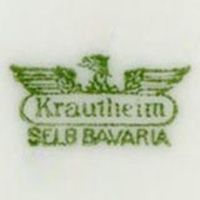
Image 010244-01-01
Used between 1884 and around 1889, the original decoration studio mark: "Krautheim" underneath an eagle.
Christoph Krautheim (full name: Johann Christoph Krautheim) was born on November 5th 1854 in Selb, his parents being the bricklayer and stonemason Johann Wolfgang Krautheim and wife Christianna Maria (neé Möckel). During his early shchool years (May 1861 until May 1868) he already developed fine skills in drawing and painting, soon trying out various techniques. His skills steadily increased and soon he was found decorating spare porcelain items.
At the age of fourteen, his father therefore let him take on an apprenticeship at the porcelain factory of Jacob Zeidler & Cie. in Selb-Plössberg, a company that had only taken up production in 1867. Following his full six year apprentice period, he was drafted into the army. He served two years as part of the 7th Infantry Regiment in Bayreuth before returning to his home town where he joined the studio of Max Jena as lead decorator until 1883. After a few years, the constant repetition of designs that he believed to be too simple and boring made him think about other possibilities. Whilst he had always kept his money together, the amount he would require to establish an own decoration studio was still out of his reach. That however changed after his engagement in December 1883 as his wife-to-be came from a respected and wealthy family; Krautheim married Henriette Anna Hermine Adelberg on May 8th 1884.
Against the advice offered by brother-in-law Richard Adelberg, who was a successful businessman in the nearby town of Erlangen, Krautheim and his wife relocated to the city of Nürnberg on the day of their marriage. Krautheim believed that Nürnberg offered a much larger amount of potential customers; the city also had direct access to multiple mayor railroad connections which (theoretically) allowed easy and cheap access to whiteware. And so Krautheim established his first own decoration studio in Nürnberg. It was located on Schlotfegerstrasse and only equipped with a small glazing oven, but offered enough room for Krautheim and his two freshly-employed apprentices.
Business development however remained far behind expectations for various reasons. Many manufacturers had given in to the market and started to offer local decorators much better prices, based on the fact that they simply dropped a certain percentage which normally would have been used towards transport and insurance. To easier understand this, one should know that the extra billed freight/insurance positions often barely covered expenses, thus a certain percentage was "hidden" in the per-piece cost (legal, but not transparent). Overall pressure on the porcelain market had resulted in a price-per-piece war, hence a reaction in form of lower (true) cost per item but increased fees for transport and insurance was the logical consequence.
In August 1885, Christoph Krautheim and his wife returned to Selb where he transformed the former house of his parents on the Gartenstrasse road into a two-storey manufactory. Consisting only of the founder Christoph Krautheim and an apprentice, the business was only equipped with a single glazing oven. Whiteware for tableware sets was purchased from the factory of Lorenz Hutschenreuther, whiteware for coffee- and tea-sets was purchased at the factories of Jakob Zeidler in Selb-Plößberg or (at least up until 1906) Jäger, Werner & Co. (not affiliated with Jäger & Co. from Marktredwitz). This time everything worked out perfectly and business steadily increased, so Krautheim's brother-in-law Richard Adelberg joined as partner on February 1st 1888. The corresponding entry at the registration office (the 'Gesellschaftsregister des königl. Landgerichts Hof') took until January 1st 1889.
Due to the change of the business type, with Christoph Krautheim as technical director and Richard Adelberg holding the position of financial director, the company was renamed accordingly; both partners equally shared responsibility and profits. In 1890 the company already employed ten porcelain painters that applied decorations completely by hand or touched up transfer decorations that were provided by six in-house printers. A quick solution to increase available workspace was needed, and so Krautheim purchased the house of his brother which was located directly next to the studio.
Knowing that this would not help for long, the company had a new three-storey building constructed in 1892 which then housed the main decoration workshop and printing rooms. At that time, the company still decorated pre-produced tableware and coffee- and tea sets only, however first plans to design their own porcelain molds were successful. These first own designs were produced for the company by various local manufacturers, even if that was an expensive and often time consuming process. Already planning further expansion the company in 1897 purchased another adjacent piece of land, the former property of the Ludwig tannery.
Based on the high quality and excellent decorations, the company had quickly advanced to one of the best in their trade and was awarded the prestigious title of 'Königlicher Bayrischer Hoflieferant' (supplier of the Royal Court) in 1899. Hermine Krautheim had not been of good health during the last years and her state deteriorated further, resulting in her passing on June 26th in 1902. After the death of his wife, Krautheim drowned himself in work and even took up on decorating items himself again. The piece of land purchased in 1897 was in 1904 used to construct a new building, allowing an expansion of the decoration rooms and printing facilities whilst additional rooms helped to expand the storage and packing facilities.
Just as Krautheim had started to overcome the untimely death of his wife, Richard Adelberg died during a trip to Altenburg on November 20th 1905. The partnership contract from 1894 stated that, in case of death, the position of one partner could only be occupied by either his wife or a legitimate male child of at least 21 years of age. Richard Adelberg however had neither, hence all active and passive positions as well as all private belongings fell to Christoph Krautheim, who decided to continue alone.
In 1911 the company employed around a hundred people and a further expansion in form of a new building on lot 34 was planned and constructed, offering urgently required room for a new offices - for now, as it was only a short-term solution. Krautheim had closely watched the market development during the last months and correspondence with suppliers clearly showed a disturbing trend: the market for well-decorated items had turned into a lucrative market segment for the manufacturers themselves. This resulted in various changes of their production methods, including the creation of specialized art departments, which in turn resulted in less available whiteware and caused an increasing competition between manufacturers and pure decoration studios.
Based on the success of the early trials with own designs, Christoph Krautheim therefore decided to completely change his company structure and take up own production. For this project he still in 1911 purchased a large piece of land (around 34,000 m²) on Schönwalder road; the ground stone for the new porcelain factory with three round kilns and an own grinding mill was laid early in May 1912. During the whole construction period and initial trial runs of the new factory, production continued at the studio as there were far too much orders that needed attention.
Construction work of the main factory finished in November 1912 and the first batches of porcelain were fired on December 1st 1912. The results exceeded all expectations and business literally exploded; the company at that time already employed around 150 people. Early in March 1913, construction work started on the new decorator building which became operational at the end of June the same year, the remaining business located on Gartenstrasse road was then able to move to the new premises.
The old buildings on Gartenstrasse road were transformed into living quarters, mostly appartments. Christoph Krautheim himself moved into the house on lot 34, the former office building. At the end of the year 1913 the company employed a total of 270 people, many of which had taken up the offer of cheap company-owned housing. Following the completion of construction work, Krautheim & Adelberg started to participate at every renown exposition and fair. Various newspaper and magazine advertisements from the 1920s and 1930s show that these events were always used to present new items and/or series that perfectly matched the taste of the time.
After having made sure that the company would remain technically competitive for the next years, Christoph Krautheim turned towards other urgent matters: it was time to talk about his ideas of a successor as he did not want to prefer a single person or future heir. The solution he had in mind was a certain business form, the GmbH. On March 21st 1921, Christoph Krautheim together with his six children therefore consulted the notary Dr. Konrad Eyermann, member of the Judicial Council in Hof, who helped to formulate the required partnership agreement.
Krautheim wanted the legal entity Krautheim & Adelberg GmbH to have a total base capital of 600,000 RM. That would be provided in form of a contribution of 204,000 RM by Krautheim himself and equal contributions of 66,000 RM from each child. In case of his demise, the six heirs would inherit an equal share from his contribution, allowing each to be present in the company with 100,000 RM. Until he decided to retire Krautheim would take up position as manager, however all vital decisions had to be signed off by the partners. As that was a straightforward approach, the partnership contract was easy to formulate and quickly signed; the company was renamed accordingly after the change in company form had been officially registered.
Even if the whole factory had only been constructed a few years back, increasing business was soon threatened by capacity limits. This triggered the first official meeting of all involved 'partners', the result leaving Krautheim convinced that his company was in safe hands - all possible ideas had been well presented and professionally discussed until an agreement was reached: the construction of a fourth kiln was approved and assigned with decision from June 8th 1921. For Krautheim, it was also the signal to slowly retire. Only a few years later, on May 1st 1925, a similar decision lead to the construction of two further kilns on the company premises. Business went really well during the next years and the company workforce slowly grew to 450 people shortly before mid-1929.
Because of the intercontinental time shift, it took until the morning of Friday, October 25th 1929 before most people in Germany became aware of what had happened on the U.S. stock market a day earlier. What is known as Black Thursday in the USA was subsequently named Black Friday in Europe, but regardless of name the result was the same: shock, then panic.
Krautheim & Adelberg of course not only exported to the US at that time, the company also had a large number of customers in the Soviet Union and many other Eastern countries. Both Christoph Krautheim and his eldest son, the designated factory manager Richard Hermann Günther Krautheim, knew that the upcoming crisis would not instantly affect business. But they also knew that restructuring measures required a certain time before they became effective, hence they instantly started to work on large scale restructuring.
Merely cutting back on the workforce of 490 people directly would have been short-sighted (in fact the number of employees was slowly decreased to 350 in 1937, an average of 20 redundancies per year). As direct result from a perfectly organized restructuring process and with Richard Hermann Günther Krautheim as manager, the company recovered and from 1935 onwards slowly started to create clean profits. Christoph Krautheim however did not live to see the fruit of his work prosper once again, he passed away peacefully in 1933. Which perhaps was a good thing, as what would become the probably darkest period of German history had only just begun.
The war years influenced the factory just like every other German export-orientated business. Management saw itself not only confronted with the typical problems of raw material shortages, loss of skilled workers, and total isolation from foreign customers but also had to fight with a completely different matter: the home market was totally different from the export market regarding prices and taste and thus demanded a complete reorientation regarding design and decoration. And of course many other manufacturers were all at the same time fighting for survival and trying to capture and hold the limited market segments.
Seen it direct comparison, it appears that the company of Krautheim & Adelberg was less affected than others, probably because the company had been a little more successful when it came to coping with the post-Depression period. Following the war, the nearly undamaged factory received a few orders for bare necessities in form of cheap household items and so it slowly recovered, employing around 450 workers again in 1949. But by then the whole porcelain market itself had changed and even former long-term business partners showed no interest in many of the pre-war designs and decorations. In addition the quality aspects had changed in favor of much cheaper and simpler designs, forcing many manufacturers to cut costs by letting off workers and concentrating on technical solutions.
During the next 25 years the Krautheim family constantly had to cope with market changes and family disputes regarding the direction in which the company should venture and the pressure eventually took its toll. Following a first near collapse in 1975 the company was forced to file for bankruptcy in 1977. As proceedings took a while, the factory was still able to produce until 1978 before it was finally forced to close; it was deleted from the trade register in 1984.
The company had a few of their mold names registered as standalone trademarks, including Carina, Gloria (registered at the RWZR as №·378·502 on December 20th 1927) and Franconia. Note that these are not decoration names but the name of the shape, therefore one should not be confused when one finds descriptions like Carina/Grizella or such (Grizella decoration on a Carina mold). Also, there is at least one further mark that I so far could not lay my hands on: an elebaorate shield with a capital "B", all above "Baroness Bavaria".

Image 010244-01-01
Used between 1884 and around 1889, the original decoration studio mark: "Krautheim" underneath an eagle.
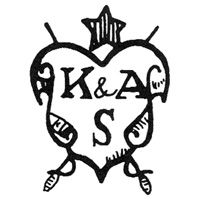
Image 010244-02-01
Used between 1889 and around 1905, the first "K&A" decoration studio mark topped by a star.
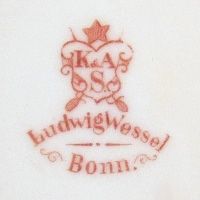
Image 010244-02-02
Example of the previously mentioned mark on an item originally manufactured by Ludwig Wessel.
(Picture: Frans Friedheim)
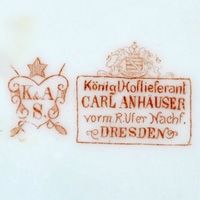
Image 010244-02-03
Example of an item (re)decorated by K&A and sold through the store of Carl Anhäuser in Dresden.
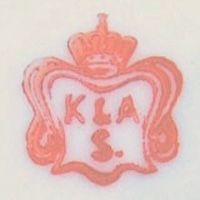
Image 010244-02-04
Used between 1895 and 1912, the commonly found second decoration studio mark topped by a crown.
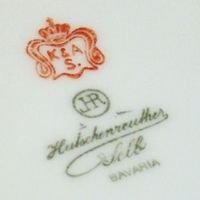
Image 010244-02-05
Same as before but found together with an original Hutschenreuther mark that was used between 1857 and 1920.
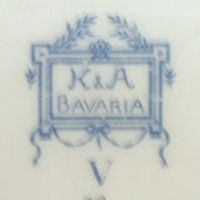
Image 010244-02-06
Used between 1889 and 1912, a series- or decoration-related mark adaption.
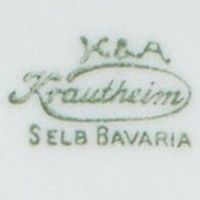
Image 010244-03/04-01
Used between 1912 and 1928, registered at the RWZR as №·202·919 on April 20th 1915.
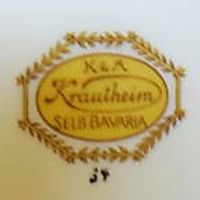
Image 010244-03/04-02
Used between 1912 and 1928, special mark found on a few completely hand-painted items.
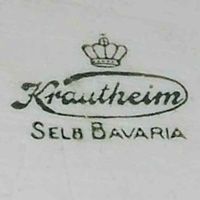
Image 010244-04-01
Mark version used around 1925, a trial version including a crown instead of the initials "K&A".
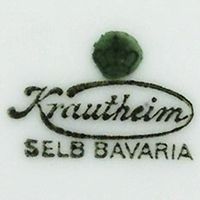
Image 010244-04-02
Same mark type as before, however it seems that even the factory did not like it as the crown was often obscured.
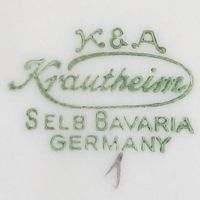
Image 010244-04-03
Used between 1928 and 1945, registered at the RWZR as №·379·451 on January 9th 1928.
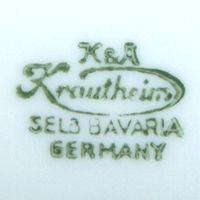
Image 010244-04-04
Used between 1928 and 1945, second version with "Selb Bavaria" and "Germany" all in capital letters.
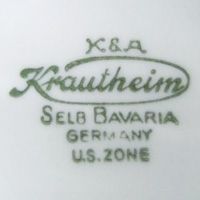
Image 010244-04-05
Used between 1946 and 1949, standard mark above "US Zone".
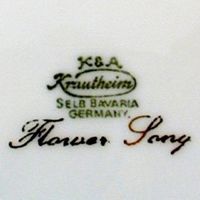
Image 010244-04-06
Used between 1949 and 1977 on items with "Flower Song" decoration.
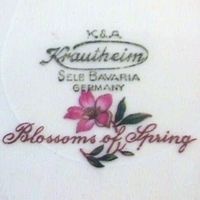
Image 010244-04-07
Used between 1949 and 1977 on items with "Blossoms Of Spring" decoration.
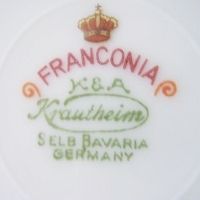
Image 010244-04-08
Used between 1949 and 1977 on items from the "Franconia" series.
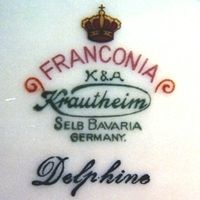
Image 010244-04-09
Used between 1949 and 1977 on items from the "Franconia" series, "Delphine" decoration.
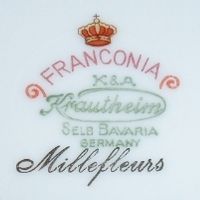
Image 010244-04-10
Used between 1949 and 1977 on items from the "Franconia" series, "Millefleurs" decoration.
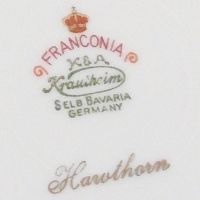
Image 010244-04-11
Used between 1949 and 1977 on items from the "Franconia" series, "Hawthorn" decoration.
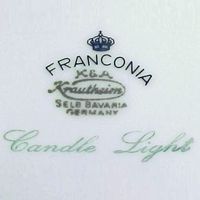
Image 010244-04-12
Used between 1949 and 1977 on items from the "Franconia" series, "Candle Light" decoration.
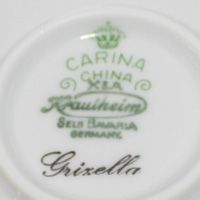
Image 010244-04-13
Used between 1949 and 1977 on items from the "Carina" series.
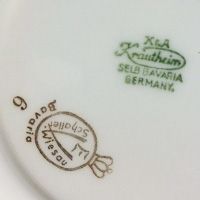
Image 010244-04-14
Example from the early 1950s, an item (re)decorated by the Schaller studio (which belonged to Winterling).
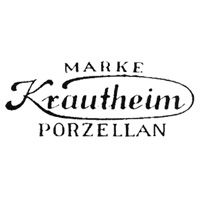
Image 010244-04-15
Used between 1953 and 1977, this green underglaze "Marke" above "Krautheim" and "Porzellan" is not found often.
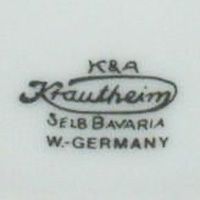
Image 010244-04-16
Used in the 1970s and somtimes hard to find: a K&A mark above "W.-Germany" instead of the regular "Germany".
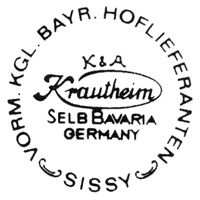
Image 010244-04-18
Used between 1960 and 1977, "Vorm. Kgl. Bayr. Hoflieferenat" mark from the "Sissy" series.
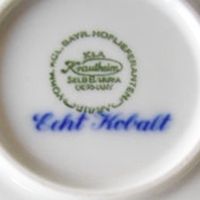
Image 010244-04-17
Used between 1960 and 1977, example of previous mark but from the "Main" series, here with "Echt Kobalt" addition.
© 2004-2026 C.S.Marshall, all rights reserved